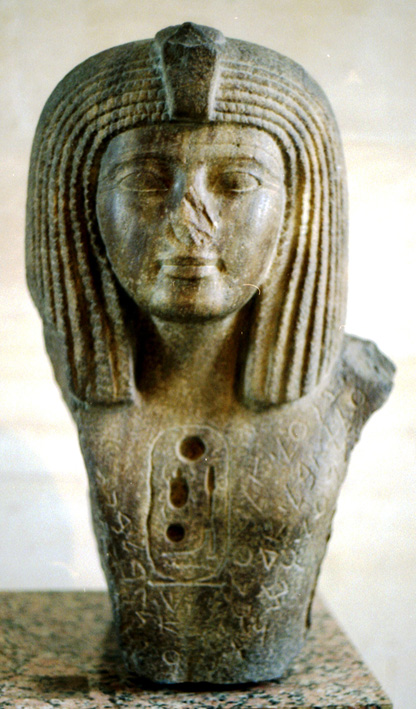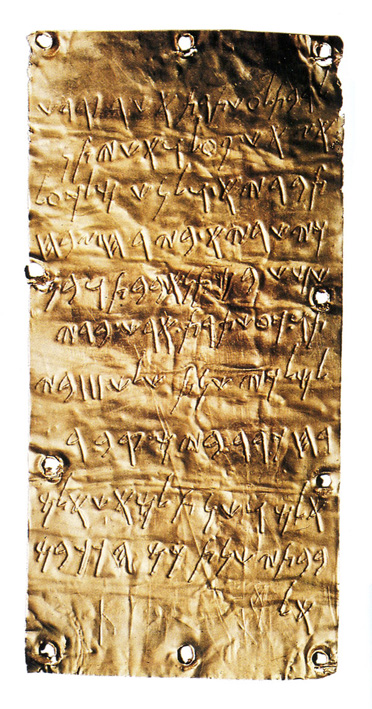Examples of writing
Inscription of Eliba‘alal king of Byblos

Phoenician inscription engraved on a statue of Osorkon I. The fragmentary statue was acquired by a private collector and subsequently purchased by the Louvre. Dating: early tenth cent. BC.
1. mš. z p‘l. ’lb‘l. mlk. gbl. byḥ [mlk. mlk gbl]
2. [lb]‘lt. gbl. ’dtw. t’rk. b‘lt [.gbl]
3. [ymt. ’]lb‘l. wšntw. ‘l[. gbl]
Translation:
1. Statue which Eliba‘al, king of Byblos, son of Yeḥi[milk, king of Byblos] made
2. [for the Ba]‘alat of Byblos, his Lady. May the Ba‘alat [of Byblos] prolong
3. [the days of E]liba‘al and the years over [Byblos]
Bibliography
Ed. princeps: R. Dussand, "Dédicace d’une statue d’Osorkon Ier par Éliba‘al, roi de Byblos", in Syria 6
(1925), 101-117.
J.C.L. Gibson, Textbook of Syrian Semitic Inscriptions, Vol. 3 Phoenician Inscriptions, Oxford 1982, n. 8.
Phoenician gold plaque of Pyrgi

Gold plaque inscribed in Phoenician letters discovered in the summer of 1964 at a sanctuary in Santa Severa (ancient Pyrgi) the ancient harbor of Cerere (now Cerveteri). This Phoenician gold plaque was discovered with two other gold plaques inscribed in Etruscan script. At present all three gold plaques are in the Museo Villa Giulia, Roma. Dating: beginning fifth cent. BC.
Text of the Phoenician plaque:
1. lrbt l‘štrt ’šr qdš
2. ’z ’š p‘l w’š ytn
3. tbry’ wlnš mlk ‘l
4. kyšry’ byrḥ zbḥ
5. šmš bmtn ’bbt wbn
6. tw k ‘štrt ’rš bdy
7. lmlky šnt šlš 3 by
8. rḥ krr bym qbr
9. ’lm wšnt lm’š ’lm
10. bbty šnt km hkkbm
11. ’l
Translation:
1. For the Lady Astarte, this (is) the holy place
2. which made and which offered
3. Thefarie Velianas king over
4. Caere, the month of ”Solar
5. sacrifice” as gift in the temple. And he built
6. an aedicule because Astarte requested (it) from him
7. year three, 3, of his reign, in
8. the month of Kirari, on the day of the deity's
9. burial. And (as for) the years of the deity's statue
10. in her temple: these (may be) so (many) years as the
11. stars.
M.G. Amadasi Guzzo, Le iscrizioni fenicie e puniche delle colonie in Occidente, Roma 1967, 158-169.
G. Garbini, L'iscrizione di Pyrgi, in RSF 17 (1989), 179-187.
P.C. Schmitz, The Phoenician Text from the Etruscan Sanctuary at Pyrgi, in JAOS 115 (1995), 559-575.
V. Belelli – P. Xella (a cura di), Le lamine di Pyrgi. Nuovi studi sulle iscrizioni in etrusco e in fenicio nel cinquantenario della scoperta, Studi Epigrafici e Linguistici sul Vicino Oriente antico vol. 32-33, Verona 2015-2016.
Theatre inscription of Lepcis Magna (Libya)

Lintel of limestone (m. 3,16×0,82) within a tabella ansata. Bilingual Latin and Neo-Punic inscription. Dating: 1-2 AD (from Latin text).
The Neo- Punic inscription reads:
1. ḥnb‘l myšql ’rṣ mḥb d‘t htmt zbḥ špt ’dr
2. ‘zrm bn ḥmlkt ṭbḥpy r’ps bt’rm btm p‘l w’yqdš
Translation of Neo-Punic inscription:
1. Hannobal, who adorns his country, who loves the perfect knowledge, sacrificer, suffete, prefect of
2. the ‘zrm-cult, son of Himilco Tapafi Rufus, made it according to the plan at his own expense and consecrated (it).
Text of the Latin inscription:
1. Imp(eratore) Caesare Divi f(ilio) Aug(usto) pont(ifice) max(imo) tr(ibunicia) pot(estate) XXIV co(n)s(ule) XIII patre patr(iae)
2. Annobal Rufus ornator patriae amator concordiae
3. flamen sufes praef(ectus) sacr(orum) Himilchonis Tapapi f(ilius) d(e) s(ua) p(ecunia) fac(iendum) coer(avit)
4. idemq(ue) dedicavit
K. Jongeling, Handbook of Neo-Punic Inscriptions, Tübingen 2008, Labdah N 16.
G. Levi Della Vida - M.G. Amadasi Guzzo, Iscrizioni puniche della Tripolitania (1927-1967), Roma 1986, n. 24a.
J.M. Reynolds - J.B. Ward-Perkins, The Inscriptions of Roman Tripolitania, Roma 1952, 321.